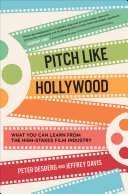

At the heart of Hollywood's success lies the art of storytelling. This idea emphasizes that compelling narratives are the backbone of any successful pitch, whether in film or business. The book outlines how to craft a story that resonates emotionally with the audience, making it relatable and memorable. It discusses the significance of character development, conflict, and resolution, drawing parallels between screenwriting and business proposals. By mastering storytelling, entrepreneurs can create pitches that not only inform but also inspire, leading to greater engagement and investment.
Continue readingOne of the critical insights from the book is the importance of understanding your audience. In Hollywood, filmmakers tailor their pitches based on the interests and preferences of producers, studios, and investors. Similarly, entrepreneurs need to research and understand their target audience, potential investors, and stakeholders. This idea encourages readers to create personas for their audience, allowing them to craft pitches that speak directly to the needs and desires of those they aim to persuade. The book provides strategies for audience analysis and how to adjust pitches accordingly.
Continue readingVisual storytelling is a powerful tool in Hollywood, and the book emphasizes its importance in pitching. It explains how visuals can enhance a presentation, making complex ideas more accessible and engaging. The use of storyboards, mood boards, and other visual aids can help convey a vision more effectively than words alone. This idea encourages entrepreneurs to incorporate visuals into their pitches, using them to illustrate concepts, evoke emotions, and create a lasting impact. The book also offers practical tips on creating effective visual presentations.
Continue readingNetworking is crucial in the film industry, and this principle applies to entrepreneurship as well. The book discusses how relationships can open doors and create opportunities, emphasizing the importance of building a robust network of contacts. It provides strategies for networking effectively, including attending industry events, leveraging social media, and seeking mentorship. By fostering connections with the right people, entrepreneurs can gain insights, support, and resources that can help elevate their pitches and overall business endeavors.
Continue readingIn Hollywood, actors and directors spend countless hours rehearsing to perfect their performances. This idea highlights the necessity of rehearsal in the pitching process. The book advocates for entrepreneurs to practice their pitches multiple times, refining their delivery and ensuring they can convey their message confidently. It discusses techniques for effective rehearsal, such as recording practice sessions, seeking feedback from peers, and simulating real pitching scenarios. By emphasizing the importance of rehearsal, the book prepares readers to present their ideas more persuasively.
Continue readingRejection is a common experience in the film industry, and the book addresses how to handle it gracefully. It discusses the importance of viewing rejection as a learning opportunity rather than a setback. Entrepreneurs are encouraged to seek constructive feedback and use it to improve their pitches and business strategies. This idea promotes resilience and adaptability, essential traits for success in both film and entrepreneurship. The book provides guidance on how to solicit feedback effectively and incorporate it into future efforts.
Continue readingIn a crowded market, standing out is essential, and Hollywood filmmakers often rely on a unique selling proposition to differentiate their projects. This idea emphasizes the need for entrepreneurs to identify and articulate their USP clearly. The book outlines how to analyze competitors, understand market trends, and pinpoint what makes a product or service unique. By developing a strong USP, entrepreneurs can create pitches that capture attention and highlight their value proposition, making it easier for potential investors to see the merit in their ideas.
Continue reading